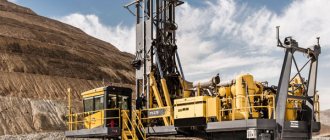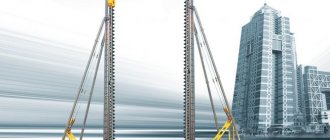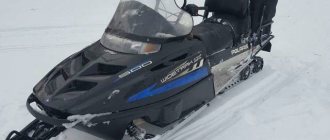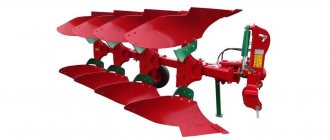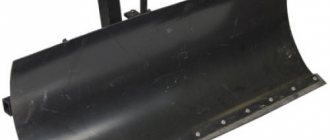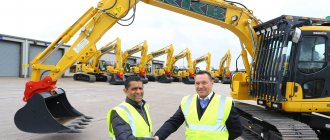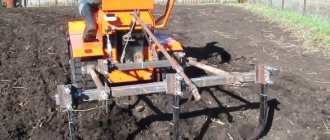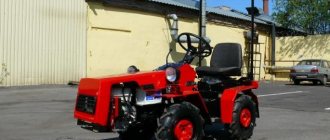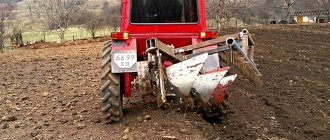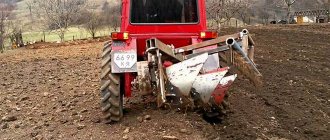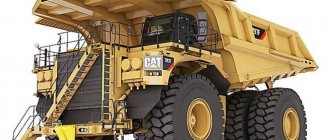V. Perelygin, Ph.D., mining engineer
Currently, drilling and blasting remains the main method of preparing hard rocks for subsequent development. Despite the many disadvantages of this method, there is still no effective alternative to it.
Drilling rigs
For one of the main technological operations of drilling and blasting operations - drilling blast holes - in open-pit mining, drilling rigs equipped with various drilling equipment are used. The standard sizes of drilling rigs are determined by the diameter of the well being drilled: 100, 125, 160, 200, 250, 320, 400 mm.
According to the domestic classification, drilling rigs are divided into three types according to the drilling method.
The first type is SBR machines, which drill by rotating a cutting tool mounted on an auger rod. Used when drilling rocks with a hardness of up to f=6 on the prof. scale. MM. Protodyakonov. The nominal diameter of drilled wells is 125 and 160 mm.
The second type is SBSh machines, which drill by rotating roller bits. The nominal diameter of the wells is from 160 to 400 mm. Used when drilling rocks stronger than f≥6.
The third type is SBU rigs, which drill using rotary impact drilling using down-the-hole hammers. They are used for drilling rocks stronger than f≥6 with hole diameters from 100 to 200 mm.
The symbol of the machine includes the borehole diameter in mm and drilling depth in m, for example, SBSh-250MNA-32: borehole diameter 250 mm, borehole depth up to 32 m.
TRAFFIC SYSTEM
The pulley (pulley) system of drilling rigs is designed to convert the rotational movement of the winch drum into translational (vertical) movement of the hook and reduce the load on the rope branches
A steel traveling rope is passed through the rope pulleys of the crown block and the traveling block in a certain order, one end of which is fixedly attached. The other end, called the running (driving) end, is attached to the winch drum.
The crown block is a frame on which axles and supports with pulleys are mounted. Sometimes the frame is made integral with the top of the tower.
Travel system equipment. As the well deepens, the weight of the load that has to be lifted or lowered continuously increases. Since the engine for the winch is selected based on the conditions for lifting or lowering a load of maximum weight, it is quite obvious that it is used ineffectively during the process of drilling a well. Its full power is used only when the well's design depth is reached, and then only when the first candles are lifted. Therefore, they strive to select a pulley mechanism that would require less power. This is achieved by using various equipment of the traveling system: 2×3; 3x4; 5x6; 6x7.
Drilling hooks and hook blocks. Drilling hooks are manufactured in the form of separate hooks or hooks connected to a traveling block (hook blocks). drill strings using slings with an elevator during tripping and ascent operations, during the drilling process for suspending a swivel with a drill string, as well as for lifting, lowering and pulling loads during drilling and installation and dismantling operations.
By design, hooks come in one-, two- and three-horned types. Currently, three-horned hooks have almost completely replaced two-horned and one-horned hooks. The presence of three horns allows the slings, suspended on the side horns of the hooks at the beginning of drilling , not to be removed until the end of drilling the well, as a result of which the work of the drilling crew is facilitated and the time spent on auxiliary operations is reduced.
According to the manufacturing method, hooks are forged, composite, plate and cast.
Machines with cutting tools
The drilling speed, and accordingly the productivity of the drilling rig, depends on the properties of the rock to be destroyed under the influence of the drilling tool, on the type of drilling, and on the design of the drilling tool. On relatively weak rocks, machines with cutter drilling tools are successfully used. The chips are separated with significant axial force by cutters mounted on the drill bit. When the rod rotates through a screw winding of the auger, the rock is removed from the well. When using a smooth rod, fines are removed with compressed air.
SBR-160A-24 machines manufactured by Karpinsky Machine-Building Plant OJSC and the earlier SVB-2M machines are traditionally widely used in CIS quarries. These are tracked vehicles with electric drive. A welded frame rests on the crawler carriage; the frame contains an oil station, control cabinets, a mast with guides for moving the drill string and rotator, cassettes for storing augers, screwing-unscrewing mechanisms, and feeding the drill string. The machine is also equipped with hydraulic cylinders for machine leveling and mast lifting, a compressor station, hydraulic and pneumatic systems, and an electrical part. Compared to outdated SVB-2M rigs, the SBR-160A-24 rig has an increased mast height, mechanized labor-intensive operations for assembling and disassembling the drill string, increased power of the drives of the main mechanisms, a hydraulic drive for raising and lowering the mast, a more spacious engine room, a heated cabin, etc. Based on the SBR-160A-24, the SBR-160B-32 was created with an increased drilling depth. The Kyshtym Machine Plant offers a more powerful and versatile machine SBR-200-32, which can also drill with roller bits (diameter 160 mm), for which it is necessary to use a trailed compressor.
The cutting bits of drilling tools differ in the number of feathers (blades), the method of their attachment, the shape of the cutting edge, and the location of the cutters on the crown. Crowns can be with either solid feathers or with removable incisors. Typically, crowns with a continuous cutting edge are used on rocks with a hardness of up to f=4 on the Protodyakonov scale. Step-shaped cutting bits equipped with cutters are designed for drilling rocks with a hardness of f<6 and containing strong abrasive layers with a hardness of f=6...8. Two incisors are attached to each feather (two feathers in total), and a two-feather notch is attached to the threaded connection in the central part. The three-flute bit already includes three cutters of different configurations on each blade and is used for drilling low-abrasive rocks with a hardness of f≤8. Four-flute bits and bits with a circular arrangement of cutters have a high coefficient of well overlap and are recommended for use with blowing the well with compressed air. This tool is used when drilling fractured low-formation rocks with a hardness of f≤8.
To achieve optimal drilling parameters, the type of bit is selected separately, the rotation speed is adjusted (if the design of the rotator drive allows) and the feed force. There is a whole family of commercially produced drill bits for use on SBR type drilling rigs.
Drilling rocks with a hardness of f>6...8 using rotary drilling rigs with cutter bits is ineffective: the wear of the cutters increases significantly, there is strong vibration of the drill bit, and the drilling speed is low. For hard rocks, roller-cone drilling is more effective. The tricone bit is fed to the bottom under a large axial force (up to 30 tf with a drilling diameter of 250 mm). The cutters are equipped with carbide teeth of various shapes (spherical or ballistic, i.e. wedge-shaped). The cutters are rolled along the surface of the face (bit rotation frequency 2.5...0.8 s–1), and the teeth are embedded into the rock under great force, creating maximum shear stresses in the destroyed layer. The flakes are separated from the rock mass and removed from the well by compressed air. Roller drilling is most effective for large borehole diameters.
EQUIPMENT FOR MECHANIZATION AND AUTOMATION OF SPO
To carry out tripping operations, the drilling crew must be equipped, firstly, with tools for gripping and hanging a pipe string (elevators, wedge grips, etc.) and, secondly, with tools for making up and unscrewing drill and casing pipes ( machine keys, round keys, etc.).
Tool for gripping and hanging pipe strings. Elevators, wedges and spiders (elevators with ram grippers) are used as such tools. Devices for gripping and hanging columns vary in size and load capacity.
Tools for making up and breaking out drill pipes and casing.
Various keys are used as such a tool. Some of them are intended for make-up, and others for fastening and loosening threaded connections of a column. Typically, light circular wrenches for pre-make-up are designed for locks of the same diameter, and heavy machine wrenches for fastening and loosening threaded connections for two, and sometimes more, sizes of drill pipes and castles.
Mechanical wrenches for screwing and fastening pipes. In order to facilitate labor and speed up the process of descent and ascent, the following are widely used:
1. Stationary automatic wrenches of the battery type, which fully mechanize all screwing and unscrewing operations, including fastening and loosening threaded connections, as well as auxiliary operations (approach and removal of the wrench, grasping and releasing the pipe), which allows speeding up these works by 8-10% . Automatic universal wrenches are produced, including those for screwing and fastening casing pipes - AKBU. Automatic keys must be equipped with a torque meter;
2. Suspended pneumatic tongs of the PBK type, mechanizing the main operations of making up drill pipes. The use of PBK type wrenches speeds up this work by 3-5%.
The main direction of automation of hoisting operations at present is equipping drilling rigs with means of mechanization and control of hoisting in an optimal mode. Optimization of tripping operations means the minimum costs of tripping and recovery, taking into account the limitations of well drilling technology.
Based on the creation of a number of mechanisms for the automation and mechanization of individual operations of lowering and hoisting work, an automatic lowering and hoisting (ASP) has been created in our country. This installation allows for comprehensive mechanization of hoisting operations. The complex of ASP mechanisms provides:
1. time combination of lowering and raising the drill pipe string and an unloaded elevator with the operations of making up and unscrewing the candles, installing them on the candle holder and moving them to the center of the well;
2. mechanization of screwing and unscrewing of spark plug connections;
3. automation of the capture and release of the drill pipe string by an elevator;
4. mechanization of installation of candles on a candlestick and their removal to the center of the well;
5. mechanization of lubrication of threaded connections of spark plugs.
The combination of operations is achieved by introducing into the installation kit a special traveling system and mechanisms for arranging candles. In the presence of these mechanisms, the drilling drawworks only raises and lowers the pipe string and the empty elevator; all operations with the unscrewed candle are performed by mechanisms for their placement. This allows you to significantly reduce the time for hoisting operations.
Roller drilling machines
The most common roller-cone drilling machines are SBSh-250MNA-32 (modified SBSh-250-55), 3SBSh-200-60 (based on 3SBSh-200N), 6SBSh-200-32 and their earlier versions.
The SBSh-250 machine manufactured by JSC Rudgormash (Voronezh) is mounted on a unified crawler UG-60. The machine frame with the engine room is mounted on the cross beams of the crawler carriage. The engine room contains a screw compressor, an oil station, hydraulic pumps, electrical cabinets and a cabin. The mast is equipped with a rotational feed mechanism, a separator with rods, and a mechanism for unscrewing the rods. Along the side panels of the mast frame there are guides along which the rotator carriages move. Three jacks are used to level the machine. The SBSh-250MNA-32 machine, which is currently being produced, is equipped with a thyristor converter to power the rotator drive, an automatic control system for compressor performance, and a hydraulic drive with increased adjustable capacity, which allows the speed of auxiliary operations to be more than doubled. A modification is proposed - equipping the machine with frequency converters, this makes it possible to use less expensive AC asynchronous motors to drive the stroke and rotator, as well as use a soft start of the compressor. A machine version with two separators on a mast has been introduced for drilling wells of different diameters on one site (by choosing the appropriate separator and rods) to a depth of up to 50 m.
Of interest is the modification SBSh-250MNA-32KP (frame-platform type) of the heavy class for drilling wells with a diameter of 250...311 mm on rocks with a hardness of f≤20. The design of the machine is adapted for work in particularly difficult mining and geological conditions. In terms of its main components, this machine is similar to the SBSh-250MNA-32; it is equipped with a more powerful rotator drive and a more efficient compressor (32...50 m3/min).
The lighter SBSh-160/200-40 and SBSh-160/200-40D (with a diesel drive), produced by Rudgormash OJSC, are direct competitors of the 3SBSh-200-60 and 6SBSh-200-32 machines of Buzuluktyazhmash OJSC. The machine from the Voronezh plant has a lighter weight and is used for drilling wells with a diameter of 160...215 mm; the machines from the Buzuluk plant drill wells with a diameter of 215...250 mm. The machines have certain design differences, in particular, the feed mechanism of the Voronezh machine is made of rack and pinion, while that of the Buzuluk machines is hydraulic.
SBU type machines
At mining enterprises where it is necessary to obtain a material with a more uniform fractional composition after the explosion and without over-grinding, for example in crushed stone quarries, a dense blasting grid is used with smaller hole diameters - from 105 to 160 mm. The most productive drilling on hard rocks, for example granites, of this diameter is carried out using SBU type machines. These machines are widely in demand when drilling hard-to-reach areas, when working in difficult mining and geological conditions, and on cramped work sites.
The physics of the rotary percussion drilling process is similar to roller drilling. The difference is in the method of creating force on the working tool. The SBU bit is equipped with carbide teeth with a spherical working surface, which are embedded in the rock under the impact force transmitted to the bit by a down-the-hole hammer or hydraulic hammer through the drill string. In this case, the rotator of the drilling rig continuously rotates the drill rod, thereby ensuring dispersed penetration of the teeth over the entire surface of the well bottom. When the teeth are introduced into the destroyed rock layer, maximum shear stresses arise; flakes break off around the teeth, which are removed from the well with compressed air.
The body of bits for rotary impact drilling consists of a head and a shank, made solid. The shape of the heads can be blade or pin (with a continuous face surface covered with teeth). There are also different methods of blowing - central, eccentric and external. Chisels can be multi-edged, their durability is higher than single-edged chisels. The K-105K blade chisel has a recess in the central part. When drilling, a core is formed in the center, which is then destroyed by a pin located between the four blades. At the same time, the energy intensity of drilling decreases, and the drilling speed increases.
For many years, machine tools of the SBU-100G-35 model from the Kyshtym Machine Plant have been successfully operated in quarries. This model is equipped with a caterpillar drive and consists of the following components: a working body, hinged in the front part of the machine, including a feed pneumatic cylinder equipped with guides along which the rotator moves. The pneumatic piston feed mechanism includes a fixed cylinder and a movable rod connected to the rotator plate.
The rotator consists of a 4 kW asynchronous motor and a planetary two-stage gearbox. The caterpillar drive consists of two carts with an individual drive for each caterpillar. The drive is an asynchronous motor and a worm gearbox with a braking device. The power source of the machines is a compressor station and a 380 V electrical network. Modifications of the machine: SBU-100N-35 - on a skid, SBU-100P-35 - on a passive pneumatic wheel. At one time, new models were created on the basis of the machine - SBU-100G-50 and 2SBU-100N-32.
The more powerful SBU-125A-32 already includes a chain feed system, a mast (rod length more than 4 m) and a cassette device for mechanized assembly and disassembly of the drill string. The rotator consists of a two-speed electric motor and a planetary gearbox. Crawler drive with individual drive for each caterpillar.
Down-the-hole hammers are a cylinder with a piston-impactor, with a valveless system. Moving in the cylinder, the piston itself blocks the compressed air circulation windows, making oscillatory movements and striking the shank of the drill bit. On modern machines, hydraulic hammers are widely used, which are installed on the machine itself together with a hydraulic rotator, and the impacts on the bit are transmitted through the entire drill string. However, this scheme is effective at shallow drilling depths, since the impact energy is lost during its passage through the drill string.
SMALL MECHANIZATION
Small mechanization includes machine keys, elevators, chisel turning boards, hooks (for supplying and discharging pipes).
The elevator is used to capture and hold a string of drilling (casing) pipes suspended during tripping and other work at the drilling rig. Elevators of various types are used, differing in size depending on the diameter of drilling or casing pipes, load capacity, design and material for their manufacture.
The elevator is suspended from a lifting hook using slings.
Drill wedges are used to suspend the drilling tool in the rotor table. They are inserted into the tapered hole between the pipe and the rotor liners. The use of wedges speeds up work on hoisting operations. Recently, automatic wedge grips with a pneumatic drive - PKR - have been widely used (in this case, the wedges are inserted into the rotor not manually, but using a special drive, the control of which is carried out on the driller's console).
Wedges for casing pipes (elevators with ram grips). To lower heavy casing strings, wedges with a one-piece body are used. The wedges are installed on special supports above the wellhead. The wedge consists of a massive body that takes the weight of the casing pipes.
Car keys. The operation of fastening and unfastening threaded connections of drill strings and casing is carried out by two machine keys, with one key (holding) being stationary, and the second (screwing) movable.
"Foreigners" on the Russian market
Currently, drilling rigs of well-known brands Atlas Copco, Tamrock, Ingersoll-Rand, etc. are widely represented on the Russian market. First of all, these are rotary-impact rigs with a diesel drive.
Such machines are indispensable when developing new deposits in remote areas where there is no developed infrastructure or power lines. Modern imported quarry drilling rigs are characterized by high productivity and mobility, can work on sites with significant slopes, and do not require power lines. The machines can drill vertical, inclined and even horizontal wells, while being on a poorly prepared site. In large quarries with developed electrical networks, Russian-made machines continue to operate successfully, with which the operating services are well familiar and there are no problems with the supply of spare parts. Technical characteristics of the machine SBSH-250MNA-32 JSC "UMMC-Rudgormash"
| Conventional well diameter, mm | 250, 270 |
| Vertical well drilling depth, m | <32 |
| Well inclination angle to vertical, degrees | 0; 15; 30 |
| Technical productivity, m/h, in rocks with strength f=12…14 | 15 |
| Voltage, V | 380 |
| Rotator motor power (DC), kW | 60 |
| Caterpillar drive motor power (AC), kW | 2x22 |
| Compressor unit | 6ВВ-32/7 Kazan compressor plant with copper oil cooler |
| Dust suppression | wet |
| Travel speed, km/h | 0,773 |
| Overall dimensions, mm, no more, with the mast raised | 9200х5450х15 350 |
| The same with the mast lowered, mm, no more | 15 000х5450х6500 |
| Weight, kg | 85 000 |
| At the customer's option, the machine can be supplied with the following changes in the basic version | |
| Well diameter, mm | 160, 190, 215 |
| Rotator motor power (DC), kW | 90; 120 |
| Track drive motor (AC with slow start), kW | 2x22 |
| Track drive motor (DC), kW | 2x35; 2x50 |
| Compressor unit | 6ВВ-32/8 Sumy Compressor Plant with a plate oil cooler made of stainless steel, a compressor unit made in Germany; 6ВВ-32/7 with aluminum oil cooler |
| Cabin | vibration-isolated, detachable from the engine room, on three jacks |
| Dust suppression system | dry |
| Capacitor bank for reactive energy compensation | |
Technical characteristics of the machine SBSH-160/200-40 JSC "UMMC-Rudgormash"
| Strength of drilled rocks | f=4…18 |
| Well diameter, mm | 160; 171; 215 |
| Drilling depth, m | 40 |
| Rod length with thread pitch 12 mm | 8,5 |
| Number of rods | 5 (4 in separator) |
| Angles for directional drilling, degrees | 0; 15; 30 |
| Pressure and lift mechanism | |
| Method of feeding drilling tools to the bottom | 2 hydraulic motors with integrated brake valves |
| Axial feed force to the face, kN | 235 |
| Axial lifting force of the drill head (high-speed lift), kN | 235 |
| Feed speed in operating mode, m/min | 0…3 |
| Drill string lifting and lowering speed, m/min | 0…15 |
| Rotation mechanism | |
| Rotator drive | two hydraulic motors |
| Drilling tool torque, Nm (kgfm) | 6867 (700) |
| Bit rotation speed, min-1 | 0…120 |
| Travel mechanism | |
| Undercarriage | tractor type |
| Hydraulic motor | 2x160 l/min |
| Travel speed, km/h | 0…1,3 |
| Climbability, degrees | 12 |
| Brake | disk |
| Compressor unit | |
| Productivity, m/min | 25 |
| Pressure, MPa | 0,7 |
| Hydraulics | |
| Working pressure, MPa | 220 |
| Jacks, pcs. | three-way - 1200 mm |
| Hydraulic cylinders for mast rotation, pcs. | 2 |
| Input voltage | |
| Supply voltage, V | 380 |
| Electrical communications | |
| Electrical equipment of hydraulic valves | 24 V DC |
| Total installed power, kW, no more | 385 |
| Dust suppression | |
| Wet, air-water mixture or dry | water tank, pump or cyclones, fan |
| Engine room | |
| Design | platform |
| Connection to travel frame | bolted |
| Cabin | |
| Design | heat and sound insulated on shock absorbers, with air conditioning and heater |
| Electronic indicator of depth, drilling speed and other parameters | on the drilling console |
| Mast | |
| Design | open type, alloy steel lattice |
| dimensions | |
| With mast raised, m | 11.5x13.3x6 |
| With mast lowered, m | 13.4x6.2x6 |
| Machine weight, t | 50 |
| Optional equipment | welding transformer, heater, device recording basic drilling parameters with the ability to transfer them to the control panel, diagnostic system for main hydraulic devices |
POWER EQUIPMENT
A power drive is understood as a complex device that converts electrical energy or fuel energy into mechanical energy and provides control of the converted mechanical energy.
The main elements of the power drive are the engine, transmission devices (mechanisms) from it to the actuator and control system devices.
The drive of the main actuators drilling rig (drawworks, mud pumps, rotor) is called the main drive. Depending on the type of engine and type of transmission, it can be electric, diesel, diesel-hydraulic, diesel-electric and gas turbine . The most widely used in modern drilling rigs are electric, diesel, diesel-hydraulic, and diesel-electric drives.
The main advantages of an AC electric drive are its relative ease of installation and operation , high reliability, and efficiency. At the same time, drilling rigs with this type of drive can only be used in electrified areas.
The diesel drive is used in areas not provided with electricity of the required power - diesel fuel, delivery. The main disadvantage of internal combustion engines is the lack of reverse, so a special device is needed to achieve reverse. Diesel internal combustion engines allow overload of no more than 20%.
The diesel-hydraulic drive consists of an internal combustion engine and a turbo transmission. A turbo transmission is an intermediate mechanism usually built between a diesel engine and a transmission. The use of turbo transmission ensures: smooth lifting of the load on the hook; engine operation if the load on the hook is greater than that which the internal combustion engine can overcome, in this case the engine will operate at reduced but quite stable rotation speeds; greater transmission durability.
The greatest advantage is the drive from DC electric motors, the design of which does not include bulky gearboxes, complex connecting parts, etc. The DC electric drive has convenient control and can smoothly change the operating mode of the winch or rotor over a wide range.
The diesel-electric drive consists of a drive motor coupled to an actuator; a generator that powers this electric motor; diesel engine driving the generator.
Terberg coiled tubing chassis for Russian oil workers
The Dutch company ASEP, a manufacturer of oil and gas equipment, purchased a KamAZ all-wheel drive chassis for installation of its installation. For future installation, they chose a small automaker, Terberg Benschop BV. So the Dutch company added a new specialized Coil Truck 8x8 chassis to its lineup, equipped with a 440 hp Volvo D13A engine, a ZF 16S2225TO manual transmission, a ZF-Steyr VG2700 transfer case and company axles Axle Tech. An additional Volvo PTO engine is used to drive the coiled tubing unit.
On this special vehicle, between the second and third chassis axles there is a long mounting section that can be raised or lowered by 400 mm, for which Terberg designers placed the engine and transfer case above the third chassis axle.
ASEP coiled tubing equipment is designed for repair and cleaning by drilling an oil well with a maximum depth of up to 10 km. To do this, the installation provides for the use of a flexible pipeline with a diameter of 1.25 or 2.38 inches, which is wound onto a drum.
The Coil Truck can operate in very harsh road and climatic conditions – at temperatures from –40 to +50 °C. For this purpose, by order of Russian oil workers, the vehicle was made in an Arctic design.
